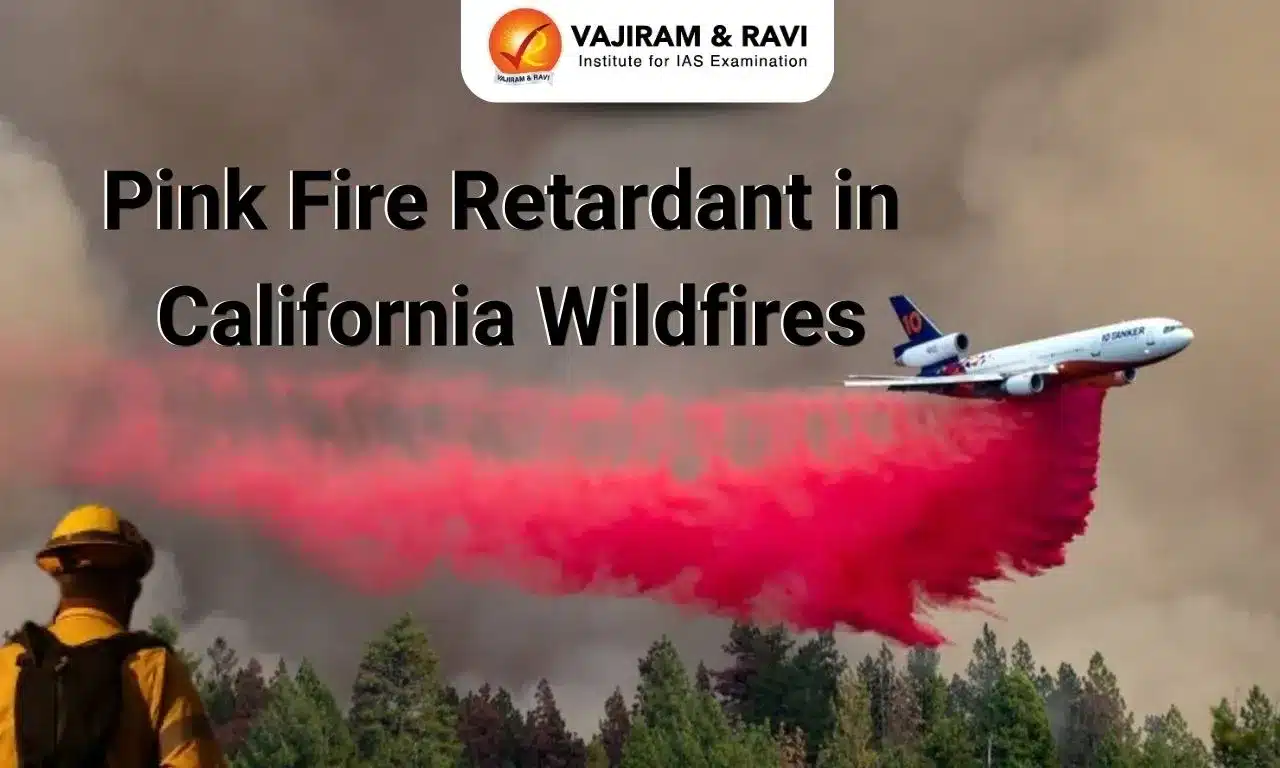What’s in today’s article?
- Why in News?
- What is the Pink Fire Retardant?
- Concerns Over Fire Retardant Use
Why in News?
Wildfires in Southern California have prompted authorities to deploy planes and helicopters to combat the blaze. Nine planes are spraying pink fire retardant, a long-used product, and 20 helicopters are dropping water.
While the fire retardant has been in use for decades, recent research questions its effectiveness and potential environmental impact.
What is the Pink Fire Retardant?
- What is Fire Retardant?
- Fire retardant is a chemical mixture designed to extinguish or slow the spread of fires.
- It is commonly used to combat wildfires, with Phos-Chek being the most widely used brand in the US.
- Composition of Phos-Chek
- Phos-Chek is primarily a mixture of water, fertilizer (ammonium phosphate), and rust-based red color.
- The formulation may also include thickening agents to control viscosity and prevent the material from drifting.
- The key active ingredient is ammonium phosphate, which helps slow the spread of fires by cooling and coating fuels, depleting oxygen, and altering how fuels burn.
- Unlike water, it does not evaporate easily and remains effective for a longer duration.
- How It Works
- Phos-Chek reacts with cellulose in plant matter, consuming heat from the fire and producing non-flammable carbon material.
- This process slows or stops the fire’s spread, especially in areas with homes or structures.
- Strategic Application
- Fire retardant is typically dropped at the edges of fires to create barriers, preventing the flames from spreading.
- Unlike water, the fertilizer-based active ingredient remains effective even after water evaporates, leaving a protective layer for days or weeks.
- Large air tankers can release up to 9,400 gallons of Phos-Chek in a single drop.
- Importance of the Pink Colour
- A pink dye is added to the fire retardant for visibility against the landscape, enabling firefighters to create fire lines effectively.
- According to experts, pink is the most visible and aesthetically pleasing option.
Concerns Over Fire Retardant Use
- Environmental Impact
- Spraying fire retardant via planes is criticized for being ineffective, costly, and a significant source of pollution to rivers and streams.
- A 2024 USC study revealed that Phos-Chek contains toxic metals like chromium and cadmium, which can harm aquatic life and potentially cause cancer, kidney, and liver diseases in humans.
- Questionable Effectiveness
- Assigning credit to aerial retardants is challenging as they are one of many firefighting methods.
- Their effectiveness depends on environmental factors like slope, fuel type, terrain, and weather, as noted by Forest Service scientists.
- Limited Scope of Use
- Experts state that aerial retardants work under a narrow range of conditions, which are increasingly rare due to climate change.
- Growing Usage Amid Intensifying Wildfires
- Rising global temperatures are expected to make wildfires more frequent and intense, escalating the use of aerial fire retardants.
- Between 2009 and 2021, over 440 million gallons of retardant were deployed in the US, releasing more than 400 tons of heavy metals into the environment.
- Ongoing Debate
- Environmental experts, the federal government, and manufacturers are at odds over the environmental and health risks posed by fire retardants, sparking an ongoing debate.
Q.1. What is Phos-Chek, and how does it work?
Phos-Chek is a fire retardant made of water, ammonium phosphate fertilizer, and rust dye. It reacts with plant matter to absorb heat, creating a non-flammable carbon layer, which helps slow fire spread, especially in areas near structures.
Q.2. What are the environmental concerns with using fire retardant?
Fire retardants like Phos-Chek contain toxic metals, including chromium and cadmium, which can pollute waterways, harming aquatic life and posing health risks to humans. Their effectiveness is also debated, as they work only under certain environmental conditions.
Last updated on June, 2025
→ UPSC Notification 2025 was released on 22nd January 2025.
→ UPSC Prelims Result 2025 is out now for the CSE held on 25 May 2025.
→ UPSC Prelims Question Paper 2025 and Unofficial Prelims Answer Key 2025 are available now.
→ UPSC Calendar 2026 is released on 15th May, 2025.
→ The UPSC Vacancy 2025 were released 1129, out of which 979 were for UPSC CSE and remaining 150 are for UPSC IFoS.
→ UPSC Mains 2025 will be conducted on 22nd August 2025.
→ UPSC Prelims 2026 will be conducted on 24th May, 2026 & UPSC Mains 2026 will be conducted on 21st August 2026.
→ The UPSC Selection Process is of 3 stages-Prelims, Mains and Interview.
→ UPSC Result 2024 is released with latest UPSC Marksheet 2024. Check Now!
→ UPSC Toppers List 2024 is released now. Shakti Dubey is UPSC AIR 1 2024 Topper.
→ Also check Best IAS Coaching in Delhi
























